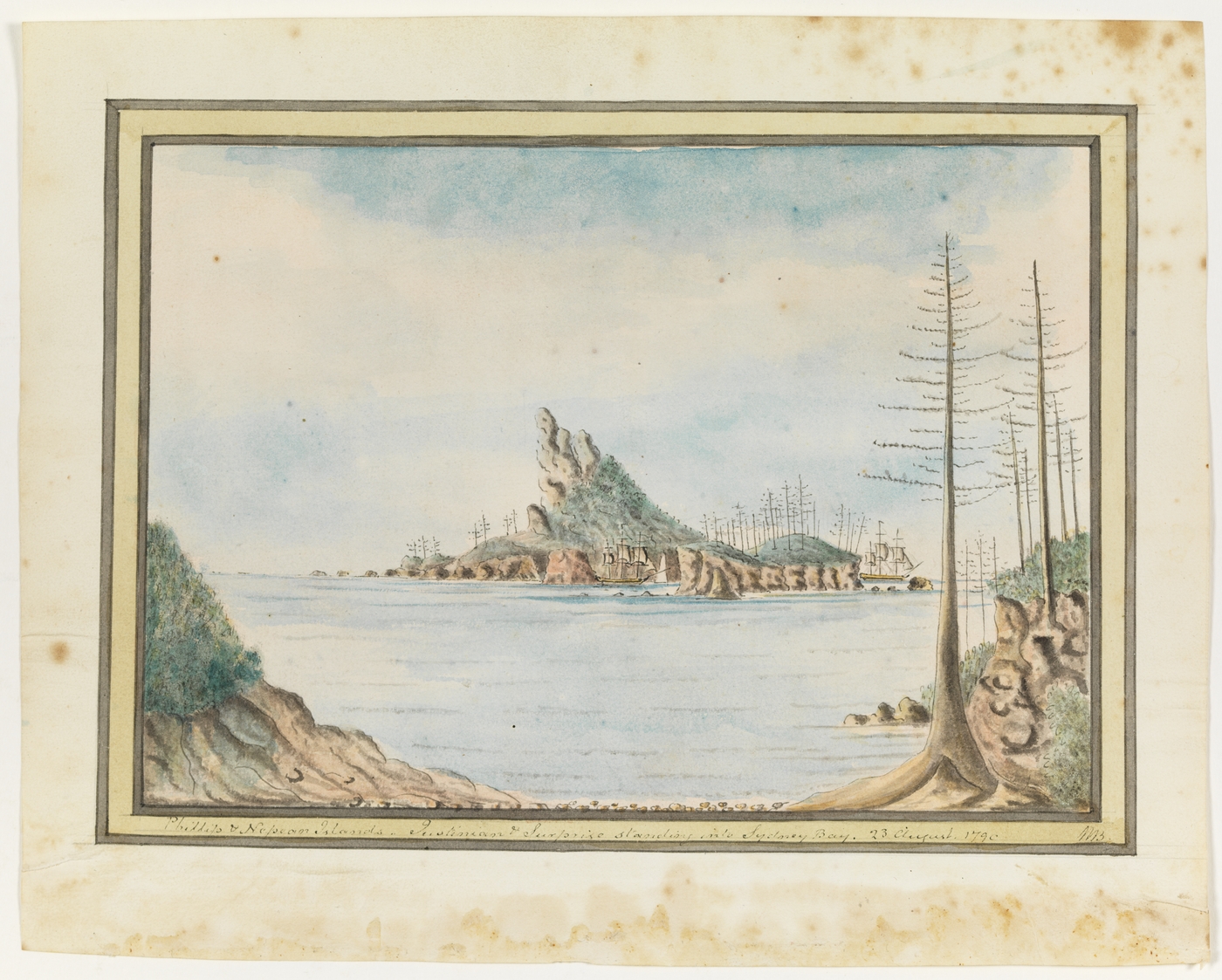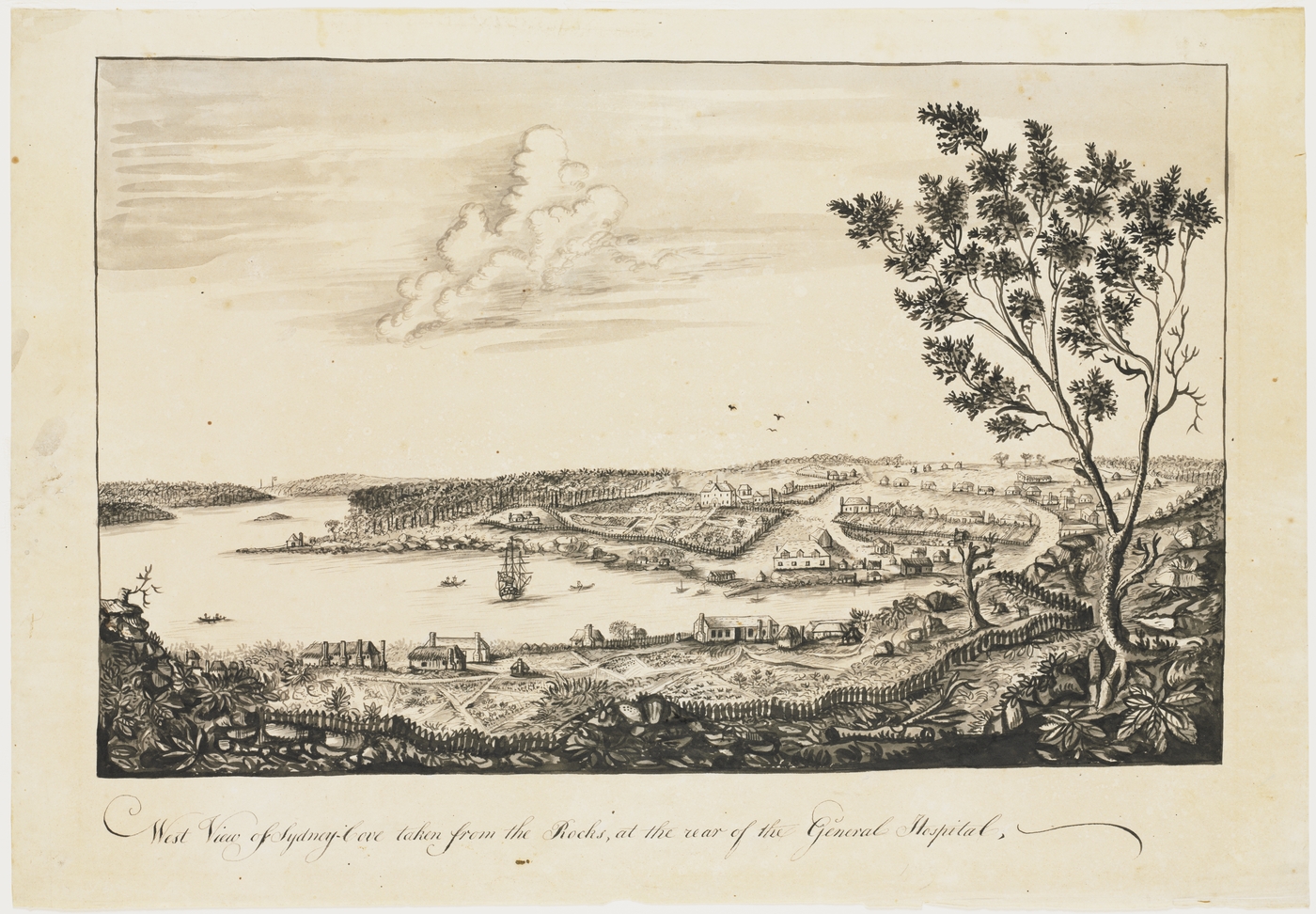The Dictionary of Sydney was archived in 2021.
Justinian
Citation
Persistent URL for this entry
To cite this entry in text
To cite this entry in a Wikipedia footnote citation
To cite this entry as a Wikipedia External link
Justinian
[media]The supply ship Justinian was the second ship of the Second Fleet to arrive in Sydney after a swift voyage of five months. Justinian was a three-decked, 389-ton ship built in Blackwall on the Thames [1] in 1787. [2]
The Second Fleet ships Lady Juliana, a female convict transport, and HMS Guardian, a supply ship, left England for New South Wales in July and September 1789 respectively. In late 1789, as the next convict transports Neptune, Scarborough and Surprize were getting ready to depart, it became clear that they would be unable to hold all the provisions that were required for the colony in New South Wales, which was nearing starvation. [3]
Recommendations were promptly made that the Government advertise for a storeship to accompany the three convict transports and convey the extra cargo. By 19 November 1789, Justinian was selected and passed inspection at the Deptford naval dockyard, [4] having recently returned from Jamaica with a cargo of sugar. [5]
Justinian was loaded with 1,400 casks of flour and 233 barrels of pork as well as smaller quantities of beef, pease, oatmeal, vinegar, spirits, oil and sugar. Also on board were cloth, clothing, blankets and a portable military hospital. [6]
Benjamin Maitland was appointed to command Justinian, and with a crew of around 36, [7] the ship departed Falmouth in Cornwall on 17 February 1790. [8] Justinian stopped briefly at Madeira, and then at Saint Jago for four days before sailing directly for Sydney. With no convicts on board, the vessel was able to bypass both Rio de Janeiro and the Cape of Good Hope, [9] arriving in Australia after an expeditious voyage of only five months.
Justinian [media]entered Port Jackson on 20 June 1790 [10] and would have arrived earlier if not for a heavy gale that drove the ship north of Black Head. [11] The female convict transport Juliana, despite having left a full six months earlier, arrived in Sydney two weeks before Justinian and brought with it the news that the Second Fleet storeship, HMS Guardian, loaded with desperately needed supplies, was wrecked after leaving the Cape of Good Hope. The successful voyage of Justinian and its cargo of provisions altered the immediate fate of the colony from 'probable starvation to probable survival'. [12]
The relief of Justinian’s arrival was, however, quickly negated by the arrival of the three transports Neptune, Scarborough and Surprize and their cargoes of sick and dying convicts. Between the three ships, fewer than 250 of more than 1,000 convicts landed in a reasonable state of health, placing an immediate strain on the colony's medical resources. [13] The hospital at Sydney Cove was soon overwhelmed and the portable military hospital brought by Justinian was immediately filled as soon as it was assembled. [14]
By 19 July Justinian’s cargo was unloaded, except for approximately 500 casks of provisions intended for the settlement at Norfolk Island. [15] At the end of the month Justinian departed Sydney for Norfolk Island and was followed three days later by Surprize. [16]
On 7 July Justinian and Surprize were sighted approaching Norfolk Island. The two ships remained for three weeks unloading provisions, mail and around 200 convicts. Surprize sailed from Norfolk Island for Canton on 29 August, and Justinian followed a day later. [17]
With the exception of the wrecked HMS Guardian, all of the second fleet ships converged on Canton between 26 October and 7 November, where they were loaded with tea to freight home. Justinian arrived in Canton on 27 October and in early December sailed along the Chinese coast to Whampoa, taking on board additional cargo. From here all five ships joined an East India Company convoy which sailed for England on 20 March 1791. [18] Along with Neptune, Scarborough and Lady Juliana, Justinian was reported to have returned to England by 2 October 1791. [19]
Further reading
Collins, David. An Account of the English Colony in New South Wales; With Remarks on the Dispositions, Customs, Manners &c. of the Native Inhabitants of that Country, volume III, 1798, edited by H Fletcher. Sydney: AH & AW Reed in association with the Royal Australian Historical Society, 1975.
Flynn, Michael. The Second Fleet: Britain's Grim Convict Armada of 1790. Sydney: Library of Australian History, 2001.
MacGregor, David R. Merchant Sailing Ships, 1775–1815: Sovereignty of Sail. Annapolis: Naval Institute Press, 1985.
Tench, Watkin. A complete account of the settlement at Port Jackson, in New South Wales : including an accurate description of the situation of the colony; of the natives; and of its natural productions / taken on the spot, by Captain Watkin Tench. London: Sold by G Nicol and J Sewell, 1793.
Notes
[1] Michael Flynn, The Second Fleet: Britain's Grim Convict Armada of 1790 (Sydney: Library of Australian History, 2001), 32
[2] David R MacGregor, Merchant Sailing Ships, 1775–1815: Sovereignty of Sail (Annapolis: Naval Institute Press, 1985), 211
[3] Michael Flynn, The Second Fleet: Britain's Grim Convict Armada of 1790 (Sydney: Library of Australian History, 2001), 32
[4] Michael Flynn, The Second Fleet: Britain's Grim Convict Armada of 1790 (Sydney: Library of Australian History, 2001), 32
[5] Watkin Tench, A complete account of the settlement at Port Jackson, in New South Wales : including an accurate description of the situation of the colony; of the natives; and of its natural productions / taken on the spot, by Captain Watkin Tench (London: Sold by G Nicol and J Sewell, 1793), available online at University of Sydney Library, http://setis.library.usyd.edu.au/ozlit/pdf/p00044.pdf, viewed 4 January, 145
[6] Michael Flynn, The Second Fleet: Britain's Grim Convict Armada of 1790 (Sydney: Library of Australian History, 2001), 32
[7] Michael Flynn, The Second Fleet: Britain's Grim Convict Armada of 1790 (Sydney: Library of Australian History, 2001), 32
[8] David Collins, An Account of the English Colony in New South Wales; With Remarks on the Dispositions, Customs, Manners &c. of the Native Inhabitants of that Country, volume III, 1798, edited by H Fletcher (Sydney: AH & AW Reed in association with the Royal Australian Historical Society, 1975), 128
[9] David Collins, An Account of the English Colony in New South Wales; With Remarks on the Dispositions, Customs, Manners &c. of the Native Inhabitants of that Country, volume III, 1798, edited by H Fletcher (Sydney: AH & AW Reed in association with the Royal Australian Historical Society, 1975), 128
[10] Watkin Tench, A Complete Account of the Settlement at Port Jackson (London: G Nicol & J Sewell, 1793) available online at University of Sydney Library, http://setis.library.usyd.edu.au/ozlit/pdf/p00044.pdf, 38
[11] David Collins, An Account of the English Colony in New South Wales; With Remarks on the Dispositions, Customs, Manners &c. of the Native Inhabitants of that Country, volume III, 1798, edited by H Fletcher (Sydney: AH & AW Reed in association with the Royal Australian Historical Society, 1975), 127
[12] Siân Rees, The Floating Brothel: The Extraordinary Story of the Lady Julian and its Cargo of Female Convicts Bound for Botany Bay (Sydney: Hodder Headline Australia, 2001), 211
[13] Michael Flynn, The Second Fleet: Britain's Grim Convict Armada of 1790 (Sydney: Library of Australian History, 2001), 46
[14] Michael Flynn, The Second Fleet: Britain's Grim Convict Armada of 1790 (Sydney: Library of Australian History, 2001), 60
[15] David Collins, An Account of the English Colony in New South Wales; With Remarks on the Dispositions, Customs, Manners &c. of the Native Inhabitants of that Country, volume III, 1798, edited by H Fletcher (Sydney: AH & AW Reed in association with the Royal Australian Historical Society, 1975), 132
[16] Michael Flynn, The Second Fleet: Britain's Grim Convict Armada of 1790 (Sydney: Library of Australian History, 2001), 52
[17] Ralph Clark, Journal and letters 1787–92, State Library of New South Wales, Mitchell Library, Safe 1/27a, b, online at http://www.acmssearch.sl.nsw.gov.au/s/search.html?collection=slnsw&meta_e=410289, viewed 4 January 2016, 161
[18] Michael Flynn, The Second Fleet: Britain’s Grim Convict Armada of 1790 (Sydney: Library of Australian History, 2001), 52
[19] Northampton Mercury, Saturday 8 October 1791, 1
.




